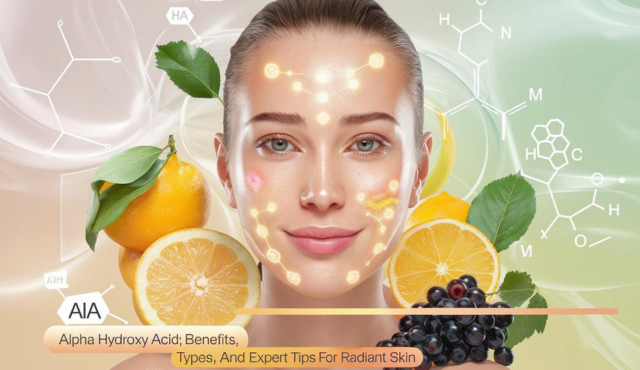
Alpha Hydroxy Acids (AHAs) are powerful, naturally occurring acids that have revolutionized skincare routines around the world. Found in fruits, milk, and sugarcane, these acids work wonders for exfoliating the skin, promoting a brighter and smoother complexion. But how do AHAs actually benefit your skin, and what makes them so effective?
In this guide, we’ll explore the key benefits of Alpha Hydroxy Acids, different types like glycolic and lactic acids, and expert tips to make the most of them in your daily skincare routine. From reducing fine lines and pigmentation to improving skin texture, AHAs can be the secret to achieving radiant, youthful-looking skin. Whether you’re new to AHAs or looking to enhance your skincare game, understanding how to incorporate them safely is essential for glowing results.
Let’s dive into the science behind AHAs and learn how to harness their potential for a flawless, radiant complexion!
What are AHAs?
Alpha Hydroxy Acids (AHAs) are water-soluble acids derived from natural sources like fruits, milk, and sugar. They exfoliate the skin by dissolving dead skin cells, promoting cell turnover, and improving skin texture. AHAs are commonly used to reduce fine lines, uneven pigmentation, and boost overall radiance.
How Alpha Hydroxy Acid (AHAs) Work on the Skin?
Alpha Hydroxy Acids (AHAs) work by gently exfoliating the skin’s surface. These water-soluble acids break down the bonds between dead skin cells, allowing them to shed more easily. This process reveals fresher, smoother skin underneath, promoting a brighter and more even complexion. AHAs also stimulate collagen production, which helps reduce the appearance of fine lines and wrinkles, making the skin look firmer and more youthful.
In addition to their exfoliating benefits, AHAs improve skin hydration by enhancing its ability to retain moisture. This combination of exfoliation and hydration makes AHAs ideal for a radiant, glowing complexion.
Benefits of Using Alpha Hydroxy Acids in Skin Care
Alpha Hydroxy Acids (AHAs) offer numerous skincare benefits.
1. Exfoliation: AHAs gently remove dead skin cells, promoting a smoother complexion.
2. Improved Skin Tone and Radiance: They help even out skin tone and boost radiance, giving the skin a healthy glow.
3. Anti-Aging Benefits: By stimulating collagen production, AHAs reduce fine lines and wrinkles, promoting youthful-looking skin.
4. Hydration: AHAs improve the skin’s ability to retain moisture, keeping it hydrated and supple.
5. Treatment of Acne: Their exfoliating properties help unclog pores and prevent acne breakouts, making them effective in acne treatment routines.
Types of Alpha Hydroxy Acids that are Widely Used in Skin Cosmetics
Several types of Alpha Hydroxy Acids (AHAs) are commonly used in skincare products:
a) Glycolic Acid: Derived from sugarcane, it’s the most effective AHA for exfoliation and stimulating collagen production.
b) Lactic Acid: Found in milk, it gently exfoliates and hydrates the skin, ideal for sensitive skin types.
c) Citric Acid: Extracted from citrus fruits, it brightens the skin and helps balance pH levels.
d) Malic Acid: Derived from apples, it provides mild exfoliation and enhances skin hydration.
e) Tartaric Acid: Found in grapes, it helps smooth skin texture and improve overall radiance.
How to Incorporate AHAs into Your Skincare Routine
Incorporating Alpha Hydroxy Acids (AHAs) into your skincare routine can greatly improve your skin’s texture and appearance, but it’s important to do it carefully for the best results.
Choosing the Right AHA:
Select the AHA that suits your skin type. Glycolic acid works well for oily and acne-prone skin, while lactic acid is gentler for sensitive or dry skin. Start with a lower concentration (5-10%) if you’re new to AHAs, then gradually increase as your skin adapts.
Patch Testing:
Before applying AHAs all over your face, patch test on a small area. This helps ensure that your skin won’t react negatively, especially if you have sensitive skin or are prone to irritation.
Sun Protection:
AHAs can make your skin more sensitive to the sun, so applying sunscreen daily is essential. Opt for SPF 30 or higher to protect your skin from sun damage and prevent pigmentation issues.
Consulting a Dermatologist:
If you have specific skin concerns like severe acne or rosacea, consult a dermatologist before incorporating AHAs. They can recommend the best type and concentration for your skin type and needs, ensuring safe and effective use.
By following these steps, you can enjoy the benefits of AHAs while minimizing any risks.
What are the Potential Side Effects and How to Handle Them?
While Alpha Hydroxy Acids (AHAs) offer many skin benefits, they can cause potential side effects, especially for sensitive skin.
Irritation and Redness: Some people may experience burning, redness, or irritation when first using AHAs. To minimize this, start with a low concentration and gradually increase it as your skin adjusts. If irritation persists, reduce usage or switch to a milder AHA like lactic acid.
Dryness and Peeling: AHAs exfoliate the skin, which can sometimes lead to dryness and peeling. To prevent this, use a moisturizer daily to keep the skin hydrated, and limit AHA use to 2-3 times per week.
Increased Sensitivity to Sunlight: AHAs can make your skin more vulnerable to UV damage. Always apply sunscreen with SPF 30 or higher during the day to protect against sunburn and pigmentation issues.
If side effects become severe, it’s best to discontinue use and consult a dermatologist for further guidance. Proper use and precautions can help you enjoy the benefits of AHAs while minimizing potential risks.
Conclusion: CTA
In conclusion, Alpha Hydroxy Acids (AHAs) are a powerful tool in skincare, offering benefits like exfoliation, improved radiance, and anti-aging effects. By choosing the right type of AHA and incorporating it safely into your routine, you can unlock smoother, brighter, and more youthful skin.
At RevieraOverseas, we understand the importance of using high-quality ingredients in skincare. Our expert formulations harness the power of AHAs to deliver effective and gentle solutions for all skin types. Whether you’re new to AHAs or looking to enhance your skincare routine, following these tips will help you achieve radiant, glowing skin.